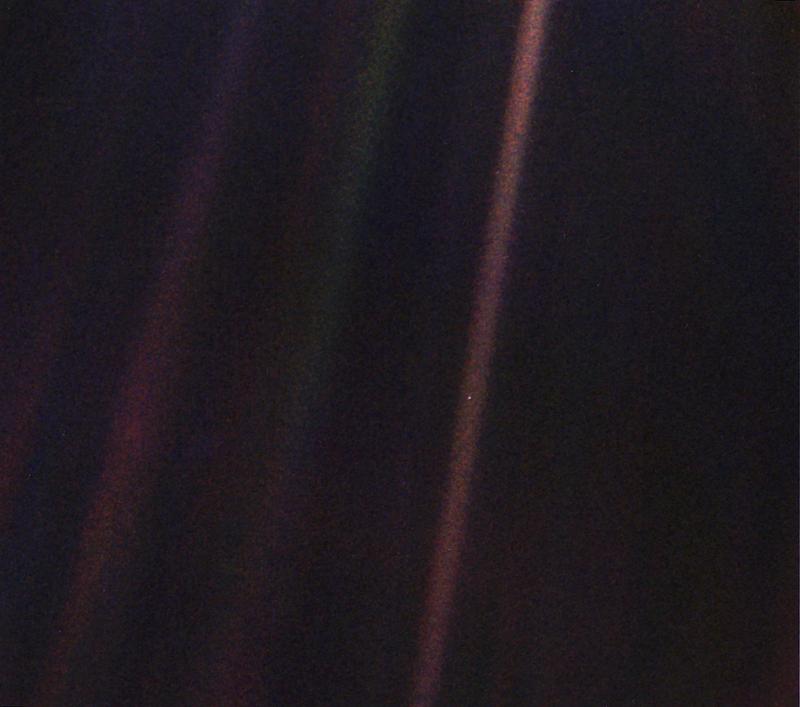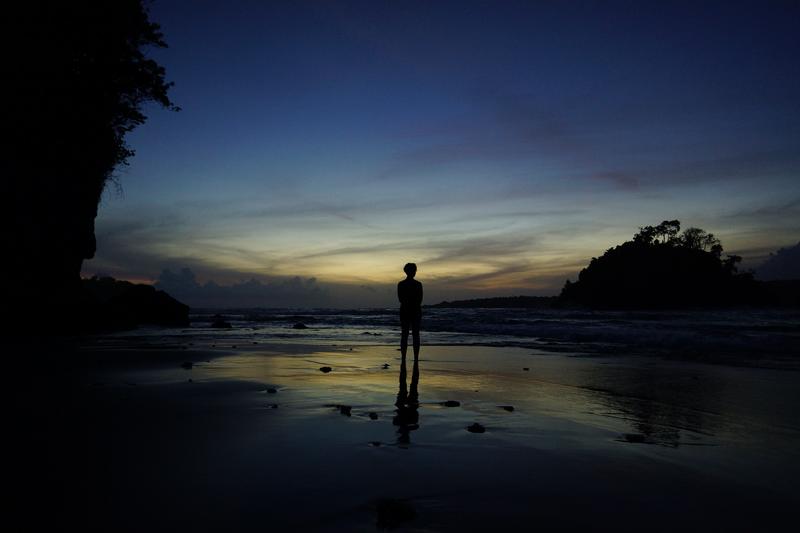Beauty In The Sky
I took this photo at sunset on an island off the coast of Bali. K walked out about ten minutes before the sun set and quietly stood, watching it sink towards the horizon. Not wanting to disturb her reverie, I stood back and framed a number of photos like this one, playing with the darkening silhouettes of a cliff to my left and the small island to my right, trying to frame her, her reflection on the wet sand, and the sunset in the sky in just the right proportions, just the right light, just the right colors. This photo is my favorite.
When she was done, she asked me if I felt the sunset was as beautiful as she felt it was. I said I thought it was beautiful, but I didn’t feel it was beautiful; perhaps a narrow distinction but an important one to me. She described for me how she felt, and it was a description of tranquility, peace, awe, beauty, and quiet. I wish I could remember more of what she said, but she described her experience in a way I wish I felt.
Not wanting to break the spell, I kept my appreciation of the moment to myself. I know that sometimes the way I see things is very different from the way others see them, and, like many seem to, I have difficulty conveying the totality of what I think or feel with words. Occasionally the inspiration does strike me, and I wish I were able to convey this to her then.
What I see when I look at this sunset is more than the colors, more than the fading light. I see a nearby star, so like its cousins many lifetimes away, slowly being hidden by the bulk of the Planet we stand upon. This Planet spins around its axis, itself spinning around its star. The Sun does not set; we turn away from its light. The light we see is already more than seven minutes older than when it left the surface of the Sun, but by some measures it is older than humanity, the photons having spent much of their life bouncing around the interior of that massive sphere of hydrogen, desperately burning in the fire of a nuclear reaction billions of years old.
That light passes through empty, cold space, passes through the sheath of magnetic fields that protect all of us from the worst that star has to offer, and diffracts through our atmosphere. Even as we see it, the Sun isn’t where we think it is as it sinks to the horizon, actually approximately one solar disc’s worth farther away. In more simple terms, when you see the sun touch the horizon, it’s just dipped entirely below the horizon in reality; we only see the refracted light rays bending through the atmosphere. The colors seen in the sky partially come from that refraction, partially from the scattering of the clouds, and, sadly, partially from the amount of pollution in the atmosphere that splits the light into its hues of red, yellow, and blue.
Then, as the light fades, we see something closer to the true sky when light does not occlude it. We see a glimpse, still veiled by light and atmosphere, of the depth of that Universe that stretches out before us. More near to us is the Milky Way, that dazzling strip of lights that appears in the darkest part of our nights, if at all. That comes from billions of stars burning their own light millions of light-years away, some already expired in the time that light has made its way to us. All those stars, perhaps with their own planets spinning around them, spin around the vast cluster of stars and black holes at the center of our galaxy.
As we hurtle around the Sun, the Sun itself hurtles around the center of the galaxy. We do not carve a circular path or even an elliptical one through space; instead, we draw helixes, or perhaps spirals, dragging along with us our Moon. That pull is caused by gravity, but not as an invisible force that most people think of it. The mass of the planet is so great that it bends space around itself in a way we cannot see but can only conceive in our minds, pulling smaller masses towards itself. That process repeats again and again at larger and larger scales; we are drawn to the Earth, the Moon is drawn to the Earth, the Earth is drawn to the Sun, the Sun is drawn to the Galaxy, and the Galaxy travels the Universe, expanding away from a brief moment at the beginning of Time where Everything Began.
Even now we slowly move towards another neighbor galaxy with which, in hundreds of millions of years, we will collide. But not in the same way we might think of a traffic collision, in which two massive objects expend their energy uselessly in trying to dominate the other. There is so much empty space in a galaxy that we will simply pass through, paths altering as masses bend space to draw other masses towards them. What will happen at the “end” of this “collision” I don’t think anybody really knows, but it will continue on, inexorably.
And as the darkness grows, we start to see the pinpricks of light signifying the presence of our brighter galactic neighbors. Others are occluded, but they wait behind the veil of light and other interference. Some of those neighbors stand in shapes to which we have given names, but if we were to ever reach them, many would not appear as we see them. Their shapes are only shapes to us, as if we were to visit them we would find them many light-years in front of or behind each other, casting something of a shadow towards us that remind us of bears, or horses, or warriors. Even the nebulae we think of as beautiful banks of fog in the stellar sea are so diffuse that if we travelled into them, they would disappear.
All of this we conceive, all of this we consider, all of this we observe in the smallest fraction of the consideration of these Titans. All we have ever known, as a species, is still a tiny fraction of the life of even our planet. Cosmos gives us an explanation by way of analogy; if the beginning of the universe began on January 1st of a calendar year, humanity as we know it only began on the last day of the year, December 31st, 35 million years ago, and what we think of as “now” is the end of that day, New Year’s Eve. The totality of humanity has happened on that day, and the totality of any of our lives is less than a second’s worth of time on that Universal Calendar. All of everything you know has happened in that final Second. Or as Carl Sagan said,
Look again at that dot. That’s here. That’s home. That’s us. On it everyone you love, everyone you know, everyone you ever heard of, every human being who ever was, lived out their lives. The aggregate of our joy and suffering, thousands of confident religions, ideologies, and economic doctrines, every hunter and forager, every hero and coward, every creator and destroyer of civilization, every king and peasant, every young couple in love, every mother and father, hopeful child, inventor and explorer, every teacher of morals, every corrupt politician, every “superstar,” every “supreme leader,” every saint and sinner in the history of our species lived there-on a mote of dust suspended in a sunbeam.
That pale blue dot is our ship, our vessel, our sanctuary of the cold dark between the stars. We do not control it but we journey on its surface, looking out from that surface, not peering through narrow portholes. One night, lay down on the ground and look out at the night. See yourself, not as looking “up” at the sky, but instead with all the mass of the Earth behind you, holding you gently to its side, and look out on infinite vastness. You won’t fall, I promise.
All of this does not mean that what we do does not matter. In fact, given the vastness of all that is, all the chance, choice, and circumstance of all that has happened to lead you to this moment of staring at a sunset, with me, stands uniquely among all the things that have ever happened. And the record of that moment may not survive; it may simply pass into nothingness. But still, it is beautiful.
